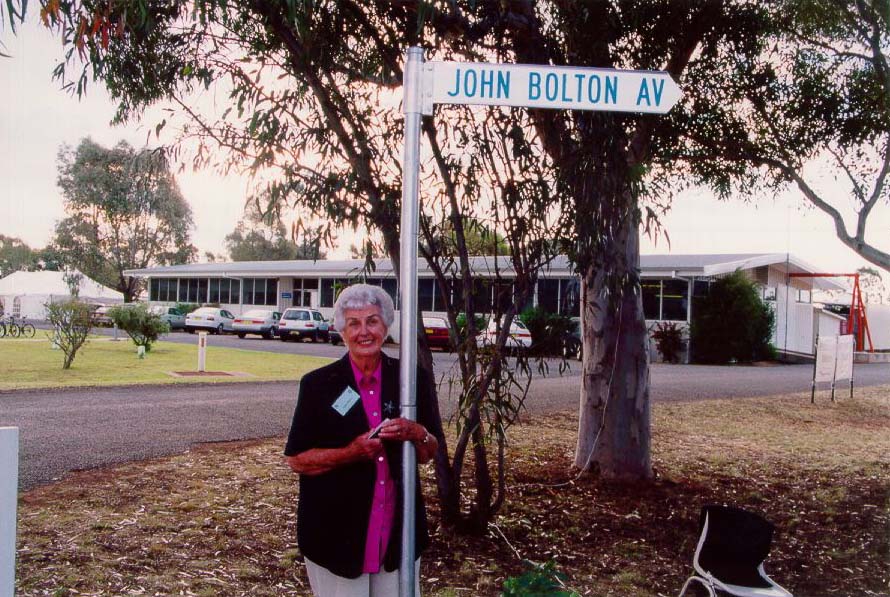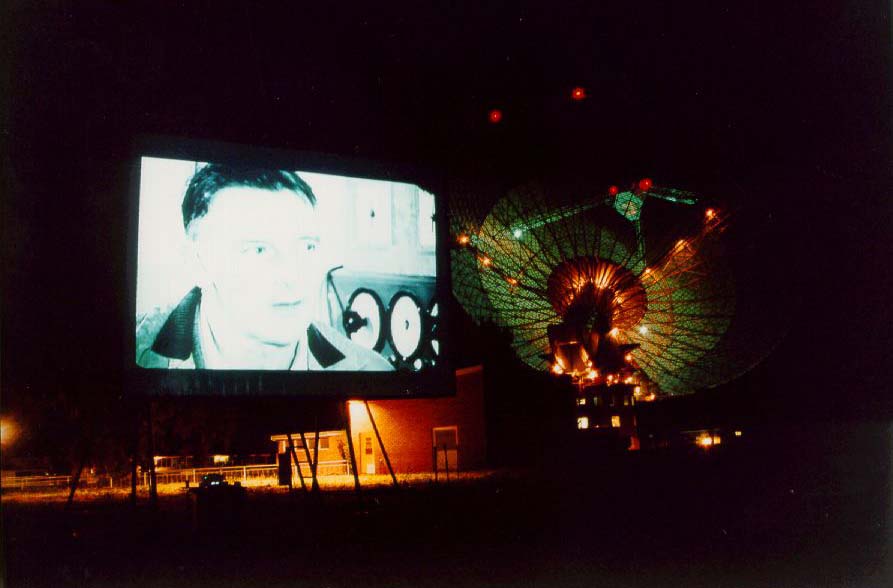Parkes Observatory report
Staff
Louise Munday joined the Observatory as the new trainee in Administration, following the departure of Stacey Jefferey. We wish Stacey well in her new endeavours.
Tim Ruckley arrived in mid January to fill the electronics technician position left vacant by the departure last year of John Glowacki.
After working through to the end of the school year, Margaret Glowacki left the Observatory in January to join her husband John in Darwin. The loss of Margaret's experience and expertise are keenly felt. We wish both of them all the best in their new careers.
Lyn Millgate joined the hard working band of casuals in the Visitors Centre shortly before Christmas, just in time for the holiday peak period.
Lewis Ball has been reappointed as Deputy OiC for a further term of nine months, pending advertisement of the position.
Parkes 40th birthday
On Thursday 1 November the Observatory commemorated 40 years of unbroken scientific achievement with a half-day symposium "Parkes: 40 years of scientific excellence", held at the Visitors Centre. Over a hundred ATNF staff, retirees and invited guests heard a programme covering the entire life of the telescope, from recollections of the early days to signposts for future directions, but with particular emphasis on recent scientific highlights in HI and pulsar work. The wide-ranging programme was reflected in the span of ages and diversity of presentation styles of the six invited speakers. There was unanimous agreement from all who attended that the Symposium was an outstanding success.
At the conclusion of the Symposium, special guest of honour Lettie Bolton, widow of the Observatory's first Director, took part in a small ceremony officially naming the tree-lined avenue from the telescope to the Observers' Quarters as the John Bolton Avenue. (Wags suggested "The John Bolton Way" might've been more appropriate, given John's often uncompromising views on many subjects).

Lettie Bolton at the opening of the John Bolton Avenue
In recognition of the important role played by the Observatory in the local community over the last four decades, the Mayor of Parkes, Cr Robert Wilson, presented the Observatory with a fine engraved clock. All then adjourned for an excellent dinner in a marquee set up adjacent to the Visitors Centre. Informal presentations over dessert from Peter Churchill and Mike Dinn (current and former Directors respectively of Tidbinbilla), and recollections from many older members of the party, including Bruce Slee and Lettie Bolton, concluded a most memorable and enjoyable day.
Observatory open weekend
On the following weekend of 3-4 November, the Observatory held an Open Weekend. Several special activities were provided to entertain and educate interested members of the public on the history and important continuing research work of the Observatory. Foremost among these were the telescope tours, proving just as popular as they did on the last Open Weekend in October 1998. Some 1800 people were conducted through the tower over the two days, a figure which is evidently close to the physical limit, given the genuine curiosity and wonder shown by the public in the details of the telescope and consequently their reluctance to be rushed through too quickly! Special thanks go to Professor Matthew Bailes, Haydon Knight and Jamie Stevens for not only attempting stoically to maintain normal observing throughout both days, but explaining their work so clearly and patiently throughout to the endless procession of visitors.
Astronomy lectures and the "meet an astronomer" marquee were also very popular. For the more adventurous, a local charter company ran helicopter joyflights over the telescope throughout both days, a novelty deemed a great success on all sides.
A highlight of the weekend was an outdoor screening of the movie "The Dish", held on the Saturday night in a paddock adjacent to the dish. (For the historically minded, the projector screen was mounted on the frame of the long disused 408-MHz calibration horn, so beloved of Marc Price). With a BBQ provided by Rotary of Parkes prior to the screening, an estimated audience of about 600 from far and wide settled back and enjoyed the film on a beautiful evening with the illuminated 64-metre as the backdrop. As if on cue, the moon rose behind the screen about halfway through - a truly magical moment! Many letters appeared subsequently in the local papers pronouncing the evening a tremendous success, and requesting it become a regular event!
In all about 2600 people visited the Observatory over the weekend, in addition to the 600+ at the movie screening. Most stayed for several hours, and our feedback was entirely positive. The Visitors Centre predictably broke all previous trading records. Many thanks to all Observatory staff, friends and families who put in so much of their time and effort to ensure the success of the event. Particular thanks also to the small but dedicated band of helpers from Epping and Narrabri, whose untiring assistance proved absolutely indispensable.
Pictures and further details of the 40th Symposium and the Open Weekend day can be found on the Observatory Social WWW pages. Follow the links from http://www.parkes.atnf.csiro.au.

Outdoor screening of the movie "The Dish".
Operations news
Operations continue to run smoothly with no major problems. The vital observing statistics for the full year 2001 were;
time scheduled for observing : 82%
time lost to all failures : 1.4%
time lost to bad weather : 2.8%
The figure for bad weather is double that for the previous year, largely due to unusually high winds in February-March 2001 and again towards the end of the year. The single worst equipment problem was a failed X-band (3-cm) receiver in the November VLBI run.
The year 2001 finished with pilot observations for the "HiPARK" project, a deep zenith-strip survey proposed by Frank Briggs and collaborators. The observations were in the main conducted remotely with the telescope at stow, demonstrating the feasibility of this mode of operation.
December saw the completion of the Northern extension of the HiPASS survey. Fittingly, the observers included Mike Disney of the University of Cardiff and Ken Freeman of MSSSO. Mike in particular was instrumental in the project from its inception, and Ken was present on the first day of observing almost five years earlier.
Observations for the Galactic Bulge extension to the Zone of Avoidance (ZOA) survey are continuing.
The other major survey of recent times is also approaching completion. At the time of writing the Jodrell-ATNF-Bologna Galactic pulsar survey is within a few days' observing of completion.
A problem affecting the Multibeam receiver has been the failure of one of the LNAs. The 1st stage LNA for beam 8B failed during cryodyne maintenance in November. This is the first total failure of any of the 26 LNAs in the Multibeam package in almost five years, a tribute to the designers and builders of the system. The impact on HI work is relatively low as the companion channel 8A is healthy and the outer six beams are less heavily used than the inner seven. However the 8A channel does have an intermittent 1/f noise excess which reduces its sensitivity for pulsar searches.
Operational developments
The new 1-GHz wideband correlator is due for installation and commissioning tests in March, with the first pulsar timing observations scheduled in April on a "shared-risk" basis. Work is underway to integrate the new correlator and a pulsar observing mode into TCS, the Observatory's main user interface.
The long-serving Caltech pulsar timing correlator has developed several serious faults recently and will be formally decommissioned as soon as the new wideband correlator is operational.
A momentous event for long-time Parkes users occurred in January with the decommissioning of the pointing program SPOT (and its derivative ZPOT), and the "RING" utility bus. The SPOT program was developed in the 1980s by Jim Roberts, among others, and has been the sole means of pointing calibration for more than a decade. It is a testament to the authors and to the stability of the VMS operating system that it has run without modification for more than ten years. (The current executable was last linked in 1991!).
Antenna pointing and calibration is now performed using the "SPOT" function built into TCS, the Observatory's main user interface. "SPOT is dead - long live SPOT!"
Mal Smith has recently been putting the recently commissioned Interference Measurement System (IMS) to good use to characterise and identify sources of interference in the HIPASS band (1364-1425 MHz). Already some interesting clues have been found to some long-standing sources of interference.
The Cal Control Unit (CCU) project is making steady progress, with the control room end of the system complete and design underway for the focus cabin unit. The purpose of this system is to provide a comprehensive, flexible and consistent means of driving the receiver noise sources and thereby to replace the existing ancient noise cal system (which is probably older than SPOT!).
Preparations are underway to replace both Zenith drive gearboxes and pinions, and to refurbish the rack gears. Delivery of the new gearbox components from Crown Engineering, Brisbane, is expected in April with a major shutdown of several weeks planned for May02 Term for installation.
Urgent preliminary work to replace some very badly rusted bolts holding the rack gears to the counterweight assembly took place during January. The time-consuming, dirty and tedious task of removing and replacing the 188 bolts began on 21 January working 18 hours per day to minimise down-time. The job was completed ahead of schedule with no major snags, thanks to the stoic efforts of the many staff and five external contractors who contributed. Special thanks to Brian Wilcockson and Paul Cooper from Marsfield, and Clive Murphy and Graeme Sunderland from Narrabri for their assistance.
Discussions are underway with NASA about the possibility of using the Parkes antenna to track one of the JPL missions planned to arrive at Mars next year. More news should be available in the next issue of the Newsletter.
Visitors Centre and outreach
Numbers at the Visitors Centre continue at record levels, with a total of 120,000 visitors for the full year 2001. Extra staff have been put on in busy periods and weekends to cope with the load. The two audio-visual shows ("The Invisible Universe" and "Catch a Star") remain extremely popular with visitors.
The inaugural meeting of the Central West Astronomical Society was held in the Visitors Centre on 1 February, with more than 50 people attending. The night was a great success, promising a bright future for the Society, which will meet at the Observatory on the first Friday of every month. Instrumental in getting the Society off the ground has been an active group of locals including the Observatory's John Sarkissian and the Bishop of Forbes-Wilcannia Chris Toohey.
John Reynolds
Officer-in-Charge
(John.Reynolds@csiro.au)
